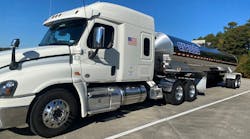FOR the past few years, the Federal Motor Carrier Safety Administration (FMCSA) has been pursuing tank truck safety, focusing more on the cargo tank repair and service facility side than the transportation side.
“We have found our cargo tank facilities a little bit needing in oversight,” said Paul Bomgardner, chief of FMCSA’s Hazardous Materials Division, in his “FMCSA Hazardous Material Update” presentation delivered June 22 during the National Tank Truck Carriers Tank Truck Safety & Security Council annual meeting in Nashville, Tennessee.
He said there are 3,200 cargo tank facilities, and they are “what keeps me up at night and what our program has been focused on.”
Whenever FMCSA closes a case and it knows there is a problem, it will release safety numbers and distribute them to the industry. Anybody connected with a cargo tank that’s in the Motor Carrier Management Information System (MCMIS) and has an email address listed with FMCSA will receive the alerts.
Bomgardner discussed the latest investigations and safety alerts:
• Notice to Canadian Cargo Tank Facilities: FMCSA issued this safety advisory as a reminder of the registration requirements for Canadian cargo tank facilities and persons engaged in the manufacture, assembly, certification, inspection, or repair of a US DOT specification cargo tank or cargo tank motor vehicle used for the transportation of hazardous materials (HM) in the United States.
He said a New York facility told FMCSA that it was using a Canadian company to test and repair its cargo tanks. But when FMCSA investigated the company, it discovered it is not registered with FMCSA.
“They had had dozens of tanks inspected and had a number of them repaired, and they had to do it all over again,” he said. “They had to recall all of those tanks and get them all redone and take them to an R-stamp shop to get the repairs. The moral of the story is, before you use any shop, Canadian or US, make sure they are registered with FMCSA. Because if they’re not, they’re not supposed to be doing that.”
• EPA Method 27 Test: FMCSA issued this safety advisory to provide notice to owners, operators, and Registered Inspectors of Cargo Tank Motor Vehicles (CTMVs) concerning the limitations on the EPA Method 27 Test when used in lieu of the Leakage Test on DOT Specification CTMVs. The EPA Method 27 Test may be used only on CTMVs with vapor recovery equipment and in dedicated petroleum distillate service.
“I’m sure this is everybody’s favorite. And no, we don’t have a final answer on this yet. But basically, the Pipeline and Hazardous Materials Safety Administration (PHMSA) changed the rule. They put out an interpretation and then we followed it up with a blurb. We are still working with PHMSA on that problem. So just stand by.”
• Recall of Certain Keith Huber Incorporated Cargo Tanks: FMCSA issued this safety advisory to provide notice to owners and operators of DOT407 and DOT412 specification cargo tank motor vehicles (CTMVs) manufactured by Keith Huber Incorporated. These CTMVs do not comply with the Federal Hazardous Materials Regulations (HMR) and do not meet DOT specification requirements in Title 49 of the Code of Federal Regulations. This safety advisory is for CTMVs manufactured by Keith Huber Incorporated prior to May 1, 2013.
“They’re vacuum tanks. We found that they aren’t using pads where they should have been. The debate is whether or not what they’re attaching is a lightweight appurtenance or not. One of things we run into time and again is the pad issue. We put out a notice and recalled 56 tanks that had to be redone.”
• E-Cigarettes: notice and information to owners and operators of CMVs concerning incidents that have occurred relating to the possession and use of battery-powered portable electronic smoking devices.
“We put this out because I got a notice that had all kinds of pretty pictures of people who had either been smoking or using one of these e-cigarettes or had it in their pockets when it just decided to ignite. It’s just a recommendation. We recommend that if your driver is driving a hazmat vehicle, you might want to be careful about lighting a cigarette.”
• Fatalities Associated with Hot Work on Tankers: Recognizing and understanding the job/hazards and the following of safe work practices can prevent potential fires, explosions, and health hazards.
“To be honest with you, I don’t know why we even have to tell anybody, ‘Do not put an open flame near a full gasoline tanker. Bad things happen.’ This particular thing is a very well-drawn alert. We’ve had cases that we’ve made because we saw where a cargo tank facility blew up and killed somebody. Do you know that that kind of incident is not a hazmat incident and is not reportable under F5800? It’s not. It’s an OSHA violation. But we follow up on it and we study what they were doing.”
• Fisher PRD Safety Recall: pressure relief devices (PRD) that were not manufactured or intended for use on cargo tank motor vehicles. PRDs are an integral part of the safety mechanisms for US Department of Transportation (DOT) specification cargo tank motor vehicles and are vital to ensuring the safety of hazardous materials transportation by highway.
“Basically, they were making PRDs for stationary propane storage tanks and people were buying them and putting them in MC331s. They were not robust enough for transportation and they would break. Fisher worked along with consumer protection to get the word out.”
• Immediate Testing and Repair of Certain TYTAL Cargo Tanks: provides notice to owners and operators of TYTAL cargo tank motor vehicles (CTMVs) with a capacity of 8,400, 8,717, and 10,500 gallons and primarily used for the transportation of Petroleum Crude Oil, UN1267. These CTMVs are not in compliance with the Federal Hazardous Materials Regulations (HMRs) and do not meet the DOT407 spec.
“We put this notice out because they had inadequate protection that didn’t meet the strength requirements and they also had only a pressure relief device in the large tank when they should have two. So every one of those tanks are identified by a serial number in this alert.”
• Immediate Re-inspection and Retesting of Certain Cargo Tank Motor Vehicles Required: to provide notice to owners and operators of certain cargo tanks that they have been improperly inspected and tested, and must be re-inspected and retested before being used in Hazardous Materials specification tank service. The tanks in question were tested by H&W Tank Testing, CT#8083, Ohatchee, Alabama, and Christopher Humphries, CT#13131, Jacksonville, Alabama. Cargo tanks that have been inspected and/or tested by either company from April 2011 through March 2016, must be re-inspected and/or retested in accordance with 49 CFR § 180.407 immediately by a cargo tank facility registered with FMCSA.
“This came about from a crash on the Georgia-Alabama border. The driver had just picked up a load of propane in his 1962 MC330 cargo tank. Something caused him to oversteer, the vehicle turns over, the shell hits a huge rock and that causes the tank to erupt. It went about 300 yards into the woods. Luckily it was in rural area and all it did was taken down some pine trees. The driver was seriously hurt and the vehicle completely destroyed. The National Transportation Safety Board got involved. They say, ‘That’s a pretty old tank,’ and that we should take a look at what condition that tank was in and see if it was maintained. So we did. We said, ‘It was in pretty good shape before this. We can’t find anything here but we still want to talk to the test crew.’ So our investigators went over to H&W and talked to Mr Humphries. He was 85 years old. He was asked, ‘How were you doing the internal visuals on these tanks?’ He said, ‘I don’t get inside of them anymore.’ We asked, ‘How many of these haven’t you gotten inside of?’ It came to almost 270 of them. We hit Mr Humphries with a pretty stiff fine.”
Bomgardner listed the top 25 cargo tank manufacturing facility violations:
• 172.704(a) Training requirements: General awareness/familiarization, Function-specific, Safety and or Security awareness training; No HM employee training as required.
• 172.704 (d) Recordkeeping: Insufficient training records or no training records.
• 171.8 Design Certifying Engineer: Unqualified Design Certifying Engineers.
• 171.8 Registered Inspector: Unqualified Registered Inspectors.
• 178.345-8 (c)(1) Accident damage protection: Failing to meet applicable specifications, such as the overturn protection not meeting the required strength.
• 178.345-8 (b) (1) Accident damage protection: Rear-end protection not rated at 155,000 lbs. when the piping is located in the lower 1/3 circumference of the tank.
• 178.345-8 (c) Accident damage protection: Items extending outside of the overturn protection.
• 178.345-8 (d)(2)(ii) Accident damage protection: Tanks with split rear end protection not having the required sacrificial device outboard of a shut-off valve.
• 178.345-8 (a)(3) Accident damage protection: Improper methods of attachment of the accident damage protection devices.
• 178.345-8 (d)(1) Accident damage protection: The rear-end cargo tank protection device was not designed to deflect at least 6 inches horizontally.
• 178.345-3(f)(3), § 178.337-3(f)(3), and § 178.3338-3(f)(3), Not using mounting pads when welding appurtenances to the wall of the cargo tank and or not extending at least 2 inches in each direction from any point of the appurtenance or attachment.
• 178.337-3(a)(l), l 78.345-3(a)(l) and 178.338-3(a)(l): Structural integrity, general requirements and acceptance criteria: Not manufacturing to a design margin of 4:1 as required. The maximum calculated design stress at any point in the cargo tank wall may not exceed the maximum allowable stress value prescribed in Section VIII of the ASME Code (IBR, see §171.7 of this subchapter), or 25 percent of the tensile strength of the material used at design conditions.
• 178.345-15 (b)(1) and (c)(1) Certification: Not designed or signed by a Design Certifying Engineer (DCE).
• 178.345-1 General requirements: Not constructed and certified in conformance with the ASME Code.
• 178.345-4 Joints: Welds not in conformance with Section VIII of the ASME Code: Insufficient weld material, Welding on contaminated (dirt, rust, etc) material .
• 178.345-10 Pressure Relief and Venting: Insufficient venting per surface area.
• 178.337-9(b)(6) Piping, Valves, Hose, and Fittings: Cargo tank manufacturers and fabricators failed to demonstrate that all piping, valves, and fittings on a cargo tank are free from leaks.
• 178.345-5 Manhole Assemblies: Not meeting labeling and or certification requirements.
• 178.346-5 Pressure and leakage tests: Incorrectly performing hydrostatic or pneumatic test
• 178.337-4(b), § 178.338-4 Joints: Welding procedure and or welder performance not in accordance with Section IX of the ASME Code.
• 178.338-16 Inspection and testing: The welder and or the welding procedure are not qualified or followed in accordance with Section IX of ASME.
• 178.320(b) General requirements applicable to all DOT specification cargo tank motor vehicles.
• 178.345-14 Marking: (b) name plate and (c) specification plate – incorrect or missing required information.
• 178.345-7(c) Circumferential reinforcements: Not in conformance when using baffles or baffle attachments as part of reinforcement.
• 178.345-7 (d) Circumferential reinforcements: ring stiffener used as a circumferential reinforcement member not continuous around the circumference of the cargo tank shell.










